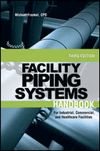ANSI/ASHRAE/SMACNA Standard 126-2000, “Methods of Testing Hvac Air Ducts,” can be used to determine hvac air duct structural strength, dimensional stability, durability, and leakage characteristics, said Herman Behls, chair of the committee that wrote the standard. Tests simulate structural stresses and conditions that ductwork will see in service.
Laboratory test procedures make sure products meet minimum requirements, as well as allow comparison of products, according to Behls and John Stratton, SMACNA director of technical services. Recommended acceptance criteria for test results can be found in the standard.
Structural tests include pressurizing ductwork, applying superimposed loads (snow and insulation), dropping weighted implements for impact or puncture, applying tension, bending flexible duct 180°, and bursting or collapsing ductwork under pressure. Durability tests (low and high temperature, humidity, and pressure cycling) simulate duct aging and rough handling. Destructive tests (burst, collapse, and puncture) evaluate the ability of ductwork to remain serviceable under severe conditions.
The standard does not cover effects of aerosols, solid particulates, corrosive environments, combustibility, or other severe exposure conditions, Behls said. ANSI/ASHRAE Standard 150-2000, “Method of Testing the Performance of Cool Storage Systems,” provides a uniform method for evaluation the performance of cool storage systems in buildings or central plants. Systems include chillers, storage medium, storage device or vessel, heat sink equipment or heat sink systems, and other auxiliary equipment.
Some cool storage systems have components that are tested by manufacturers while others have no factory-tested components. However, all systems need to be evaluated to determine if all components perform as expected when matched with an existing cooling load, said Charles Dorgan, chairman of the committee that wrote the standard. “The goal of the standard is to provide a means for owners to ensure cool storage systems meet their needs and to provide a uniform test method to prevent surprises for contractors and manufacturers of such systems,” he said.
The test method in the standard eliminates the need to develop a specific test procedure for each individual project. The standard includes a uniform method of testing, identification of test equipment for performing such tests, identification of data required and calculations to be used, and definitions and terminology.
ANSI/ASHRAE Standard 41.9-2000, “A Standard Calorimeter Test Method for Flow Measurement of a Volatile Refrigerant,” is used by manufacturers of compressors and condensing units to rate the performance of their products. The standard sets recommended practices for measuring the flow rate of volatile refrigerants using a calorimeter as a primary flow measuring instrument.
The standard includes terminology and specifications for conducting calorimeter tests for both azeotropic and zeotropic refrigerants.
The standard also can be used by other equipment manufacturers, such as those of heat exchangers, to measure refrigerant flow rates, according to Richard Hall, chair of the committee that wrote the standard.
For more information about these standards, visit www.ashrae.org.





